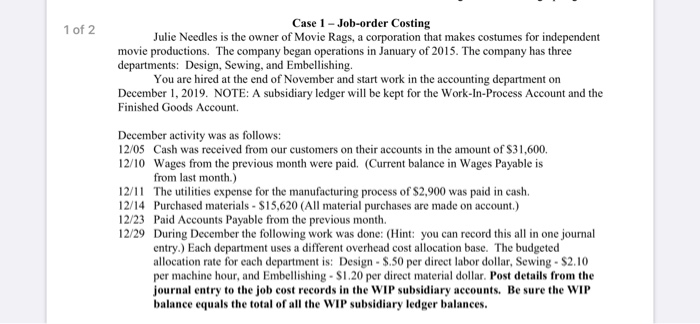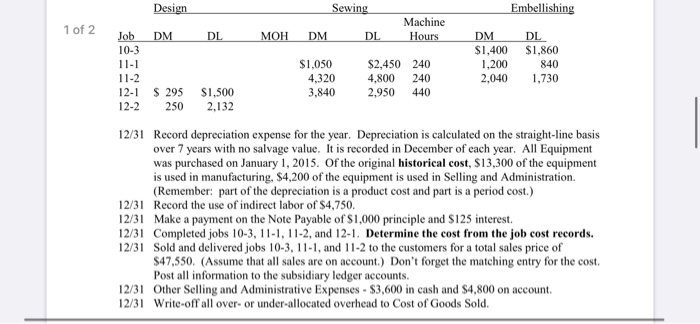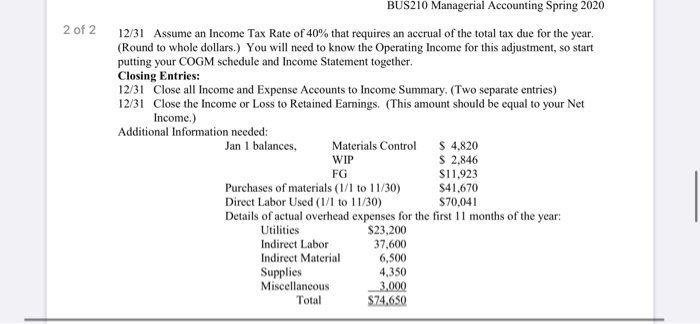Answered step by step
Verified Expert Solution
Question
1 Approved Answer
please note that subsidiary ledgers are specific ledgers for individual jobs and is needed. however the subsidiary ledgers should be compiled into one journal entry




please note that subsidiary ledgers are specific ledgers for individual jobs and is needed. however the subsidiary ledgers should be compiled into one journal entry for the entire job costing process
1 of 2 Case 1 -Job-order Costing Julie Needles is the owner of Movie Rags, a corporation that makes costumes for independent movie productions. The company began operations in January of 2015. The company has three departments: Design, Sewing, and Embellishing. You are hired at the end of November and start work in the accounting department on December 1, 2019. NOTE: A subsidiary ledger will be kept for the Work-In-Process Account and the Finished Goods Account. December activity was as follows: 12/05 Cash was received from our customers on their accounts in the amount of $31,600, 12/10 Wages from the previous month were paid. (Current balance in Wages Payable is from last month.) 12/11 The utilities expense for the manufacturing process of $2.900 was paid in cash. 12/14 Purchased materials - $15,620 (All material purchases are made on account.) 12/23 Paid Accounts Payable from the previous month. 12/29 During December the following work was done: (Hint: you can record this all in one journal entry. Each department uses a different overhead cost allocation base. The budgeted allocation rate for each department is: Design - $.50 per direct labor dollar, Sewing - $2.10 per machine hour, and Embellishing - $1.20 per direct material dollar. Post details from the journal entry to the job cost records in the WIP subsidiary accounts. Be sure the WIP balance equals the total of all the WIP subsidiary ledger balances. Design Embellishing Sewing DL 1 of 2 Job 10-3 DM DL M OH DM Machine Hours DM $1,400 1,200 2,040 DL $1,860 840 1,730 11-2 12-1 12-2 $1,050 4,320 3,840 $2,450 4,800 2,950 240 240 440 $ 295 250 $1,500 2,132 12/31 Record depreciation expense for the year. Depreciation is calculated on the straight-line basis over 7 years with no salvage value. It is recorded in December of each year. All Equipment was purchased on January 1, 2015. Of the original historical cost, $13,300 of the equipment is used in manufacturing, $4,200 of the equipment is used in Selling and Administration (Remember: part of the depreciation is a product cost and part is a period cost.) 12/31 Record the use of indirect labor of $4,750. 12/31 Make a payment on the Note Payable of $1,000 principle and S125 interest. 12/31 Completed jobs 10-3, 11-1, 11-2, and 12-1. Determine the cost from the job cost records. 12/31 Sold and delivered jobs 10-3, 11-1, and 11-2 to the customers for a total sales price of $47,550. (Assume that all sales are on account.) Don't forget the matching entry for the cost. Post all information to the subsidiary ledger accounts. 12/31 Other Selling and Administrative Expenses - $3,600 in cash and $4,800 on account 12/31 Write-off all over- or under-allocated overhead to Cost of Goods Sold BUS210 Managerial Accounting Spring 2020 2 of 2 12/31 Assume an Income Tax Rate of 40% that requires an accrual of the total tax due for the year. (Round to whole dollars.) You will need to know the Operating Income for this adjustment, so start putting your COGM schedule and Income Statement together. Closing Entries: 12/31 Close all Income and Expense Accounts to Income Summary. (Two separate entries) 12/31 Close the Income or Loss to Retained Earnings. (This amount should be equal to your Net Income.) Additional Information needed: Jan 1 balances, Materials Control S 4,820 WIP S 2,846 FG $11.923 Purchases of materials (1/1 to 11/30) S41,670 Direct Labor Used (1/1 to 11/30) $70,041 Details of actual overhead expenses for the first 11 months of the year Utilities $23,200 Indirect Labor 37,600 Indirect Material 6,500 Supplies 4,350 Miscellaneous 3.000 Total $74,650 Requirement #2 (45 points) Prepare the journal entries necessary to record the activity during December. Include a brief explanation for each entry. Post your entries to the General Ledger Accounts and Subsidiary Ledger Accounts. (You may find that you will need to post as you write the entries.) Requirement #3 (10 points) Prepare a Schedule of Cost of Goods Manufactured and a Schedule of Cost of Goods Sold. Order to turn in: 1) Unadjusted Trial Balance for November 30, 2019, 2) General Journals, 3) General ledgers, Subsidiary Ledgers, 4) Cost of Goods Manufactured Schedule, 5) Cost of Goods Sold Schedule. Check figures: Total December Manufacturing Cost Added: $41,973 Cost of Goods Manufactured = $ 230,336 1 of 2 Case 1 -Job-order Costing Julie Needles is the owner of Movie Rags, a corporation that makes costumes for independent movie productions. The company began operations in January of 2015. The company has three departments: Design, Sewing, and Embellishing. You are hired at the end of November and start work in the accounting department on December 1, 2019. NOTE: A subsidiary ledger will be kept for the Work-In-Process Account and the Finished Goods Account. December activity was as follows: 12/05 Cash was received from our customers on their accounts in the amount of $31,600, 12/10 Wages from the previous month were paid. (Current balance in Wages Payable is from last month.) 12/11 The utilities expense for the manufacturing process of $2.900 was paid in cash. 12/14 Purchased materials - $15,620 (All material purchases are made on account.) 12/23 Paid Accounts Payable from the previous month. 12/29 During December the following work was done: (Hint: you can record this all in one journal entry. Each department uses a different overhead cost allocation base. The budgeted allocation rate for each department is: Design - $.50 per direct labor dollar, Sewing - $2.10 per machine hour, and Embellishing - $1.20 per direct material dollar. Post details from the journal entry to the job cost records in the WIP subsidiary accounts. Be sure the WIP balance equals the total of all the WIP subsidiary ledger balances. Design Embellishing Sewing DL 1 of 2 Job 10-3 DM DL M OH DM Machine Hours DM $1,400 1,200 2,040 DL $1,860 840 1,730 11-2 12-1 12-2 $1,050 4,320 3,840 $2,450 4,800 2,950 240 240 440 $ 295 250 $1,500 2,132 12/31 Record depreciation expense for the year. Depreciation is calculated on the straight-line basis over 7 years with no salvage value. It is recorded in December of each year. All Equipment was purchased on January 1, 2015. Of the original historical cost, $13,300 of the equipment is used in manufacturing, $4,200 of the equipment is used in Selling and Administration (Remember: part of the depreciation is a product cost and part is a period cost.) 12/31 Record the use of indirect labor of $4,750. 12/31 Make a payment on the Note Payable of $1,000 principle and S125 interest. 12/31 Completed jobs 10-3, 11-1, 11-2, and 12-1. Determine the cost from the job cost records. 12/31 Sold and delivered jobs 10-3, 11-1, and 11-2 to the customers for a total sales price of $47,550. (Assume that all sales are on account.) Don't forget the matching entry for the cost. Post all information to the subsidiary ledger accounts. 12/31 Other Selling and Administrative Expenses - $3,600 in cash and $4,800 on account 12/31 Write-off all over- or under-allocated overhead to Cost of Goods Sold BUS210 Managerial Accounting Spring 2020 2 of 2 12/31 Assume an Income Tax Rate of 40% that requires an accrual of the total tax due for the year. (Round to whole dollars.) You will need to know the Operating Income for this adjustment, so start putting your COGM schedule and Income Statement together. Closing Entries: 12/31 Close all Income and Expense Accounts to Income Summary. (Two separate entries) 12/31 Close the Income or Loss to Retained Earnings. (This amount should be equal to your Net Income.) Additional Information needed: Jan 1 balances, Materials Control S 4,820 WIP S 2,846 FG $11.923 Purchases of materials (1/1 to 11/30) S41,670 Direct Labor Used (1/1 to 11/30) $70,041 Details of actual overhead expenses for the first 11 months of the year Utilities $23,200 Indirect Labor 37,600 Indirect Material 6,500 Supplies 4,350 Miscellaneous 3.000 Total $74,650 Requirement #2 (45 points) Prepare the journal entries necessary to record the activity during December. Include a brief explanation for each entry. Post your entries to the General Ledger Accounts and Subsidiary Ledger Accounts. (You may find that you will need to post as you write the entries.) Requirement #3 (10 points) Prepare a Schedule of Cost of Goods Manufactured and a Schedule of Cost of Goods Sold. Order to turn in: 1) Unadjusted Trial Balance for November 30, 2019, 2) General Journals, 3) General ledgers, Subsidiary Ledgers, 4) Cost of Goods Manufactured Schedule, 5) Cost of Goods Sold Schedule. Check figures: Total December Manufacturing Cost Added: $41,973 Cost of Goods Manufactured = $ 230,336 Step by Step Solution
There are 3 Steps involved in it
Step: 1

Get Instant Access to Expert-Tailored Solutions
See step-by-step solutions with expert insights and AI powered tools for academic success
Step: 2

Step: 3

Ace Your Homework with AI
Get the answers you need in no time with our AI-driven, step-by-step assistance
Get Started


